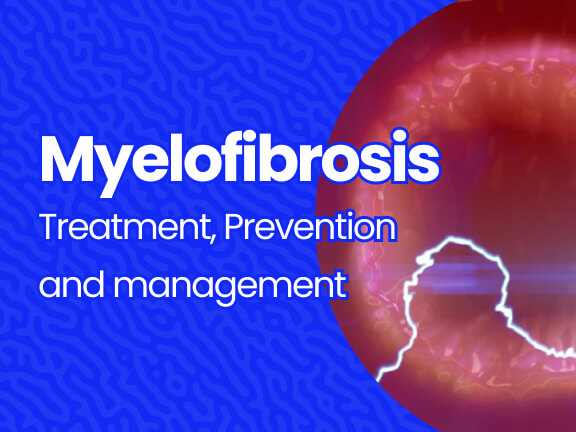Myelofibrosis Treatment, Prevention & Management
Treatment for myelofibrosis can be done in a variety of ways, depending on the patient’s symptoms and circumstances. Some people may not have symptoms for many years. Even if they do not require immediate treatment, they should be closely monitored for any changes that suggest a deterioration of their condition. The goal for the majority of patients is to manage myelofibrosis-related problems. Jakafi (ruxolitinib) is the first medicine to be approved by the FDA for the treatment of intermediate or high-risk myelofibrosis. It is a multikinase inhibitor that inhibits janus-associated kinase (JAK) signaling.
The cause of primary myelofibrosis has yet to be identified. Although myelofibrosis is not hereditary, it has been linked to DNA alterations in specific genes. Janus-associated kinases (JAKs) are proteins that play a function in myelofibrosis. JAKs control blood cell generation in bone marrow by signaling the cells to divide and expand. When JAKs become overactive, either too many or too few blood cells are created.
The JAK2 gene is mutated in around 50 percent of cases. Another 5-10 percent of patients have a mutation in the MPL gene, which causes myeloproliferative leukemia. Calreticulin (CALR) mutations account for roughly 35 percent of myelofibrosis patients.
Exposure to ionizing radiation or petrochemicals such as benzene or toluene are risk factors for myelofibrosis.
Primary myelofibrosis occurs when myelofibrosis develops on its own. Myelofibrosis can occur in patients with various bone marrow malignancies, such as essential thrombocythemia (excess platelet production) or polycythemia vera (production of excess red blood cells). Post-essential thrombocythemia or post-polycythemia vera myelofibrosis is the medical term for this condition.
What Are the Symptoms of Myelofibrosis?
A person with myelofibrosis may be asymptomatic for several years. Approximately one-third of individuals do not exhibit symptoms in the early stages of the condition. During the sickness, however, patients may encounter the following symptoms or conditions:
- Anemia: A deficiency of red blood cells often accompanied by fatigue, weakness, and shortness of breath.
- Pale skin
- Enlarged spleen (splenomegaly): This may result in a sensation of fullness or discomfort in the upper left section of the abdomen.
- Portal hypertension: An increase in blood pressure in the vein that carries blood from the spleen to the liver.
- Dilated veins in the stomach and esophagus: These veins may rupture and cause bleeding.
- Night sweats
- Unexplained blood clots
- Frequent infections
- Fever
- Itching
- Abnormal bleeding or bruising
- Enlarged liver
- Bone or joint pain
- Weight loss
- Extramedullary hematopoiesis: Abnormal growth of blood-forming cells outside the bone marrow. These cells may enter other parts of the body, such as the lungs, gastrointestinal tract, spinal cord, brain or lymph nodes. The cells can form masses (tumors) that compress organs or impair their function.

How Is Myelofibrosis Diagnosed?
Your doctor will conduct a physical examination and inquire about your medical history, as well as any symptoms you are having. The doctor will look for evidence of spleen enlargement or anemia. Among the diagnostic tests that may be conducted are:
- Complete blood count (CBC): An elevated number of white blood cells and platelets and a lower than normal number of red blood cells may suggest myelofibrosis.
- Blood tests: Elevated levels of uric acid, bilirubin, and lactic dehydrogenase may mark the presence of myelofibrosis.
Additional tests may be needed to confirm the diagnosis, including:
- Gene mutation analysis: Blood cells may be examined for certain mutations associated with myelofibrosis.
- Bone marrow biopsy: A sample of bone marrow may be removed for examination under a microscope.
- Imaging tests: An ultrasound test may be performed to check for enlargement of the spleen.
How Can Myelofibrosis Be Prevented?
Myelofibrosis cannot be avoided, although allogeneic hematopoietic cell transplantation (HCT) may offer a treatment. The treatment entails replacing a patient’s immune system with that of an appropriate donor. This new immune system searches for and kills malignant cells in the myelofibrosis patient’s bone marrow while still providing healthy blood-making bone marrow cells. Prior to the transplant, the patient must undergo chemotherapy and/or radiation therapy to weaken his or her own immune system so that the donor’s cells can take.
HCT is associated with a high risk of complications and is only appropriate for specific people. Complications are more likely in people who have other medical issues. For individuals who may be candidates for the surgery, several variables must be considered, including their age, the intensity of their symptoms, potential risk factors, and the possibility of success.
What Are the Treatment Options for Myelofibrosis?
For most people with myelofibrosis, the goal of treatment is to alleviate the disease’s signs and symptoms. Treatment options include:
Splenectomy: If your spleen becomes so large that it causes you pain and begins to cause harmful complications — and if you don’t respond to other forms of therapy — you may benefit from having your spleen surgically removed.
Chemotherapy: Chemotherapy uses powerful drugs to kill cancer cells. Chemotherapy drugs may reduce the size of an enlarged spleen and relieve related symptoms, such as pain.
Bone Marrow Transplant: Also called a stem cell transplant, is a procedure to replace your diseased bone marrow using healthy blood stem cells. For myelofibrosis, the procedure uses stem cells from a donor (allogeneic stem cell transplant).
Myelofibrosis Clinical Trials
Massive Bio specializes in finding advanced clinical treatments for every Myelofibrosis type. If you’ve been diagnosed with any of the following Myelofibrosis subtypes, we’re here to help. If you don’t know which type of Myelofibrosis you have, that’s okay. Additional testing can help you determine your exact diagnosis.
- Primary Myelofibrosis (also known as chronic idiopathic myelofibrosis)
- Chronic Myelogenous Leukemia
- Essential Thrombocythemia (ET)
- Chronic Neutrophilic Leukemia
- Chronic Eosinophilic Leukemia
- Myelofibrosis (MF)
- Polycythemia Vera Treatment (PV)
- Multiple Myeloma Treatment
- Blood Cancer Treatment
To learn more about Myelofibrosis, read our ultimate guide: Myelofibrosis Ultimate Guide
Sources:
https://my.clevelandclinic.org.













2 Comments
I have been diagnosed with myelofibrosis couple weeks ago. What are my options for treatment? How clinical trials can help me?
I am sorry to hear that you are having a tough time. We can help with connecting you to the clinical trials that best match your diagnosis.